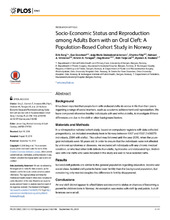| dc.contributor.author | Berg, Erik | en_US |
| dc.contributor.author | Sivertsen, Åse | en_US |
| dc.contributor.author | Ariansen, Anja Maria Steinsland | en_US |
| dc.contributor.author | Filip, Charles | en_US |
| dc.contributor.author | Vindenes, Hallvard | en_US |
| dc.contributor.author | Feragen, Kristin Judith Billaud | en_US |
| dc.contributor.author | Moster, Dag | en_US |
| dc.contributor.author | Lie, Rolv T. | en_US |
| dc.contributor.author | Haaland, Øystein Ariansen | en_US |
| dc.date.accessioned | 2016-12-19T12:12:29Z | |
| dc.date.available | 2016-12-19T12:12:29Z | |
| dc.date.issued | 2016-09-15 | |
| dc.Published | PLoS ONE 2016, 11(9):e0162196 | eng |
| dc.identifier.issn | 1932-6203 | |
| dc.identifier.uri | https://hdl.handle.net/1956/15260 | |
| dc.description.abstract | Background: It has been reported that people born with orofacial clefts do worse in life than their peers regarding a range of social markers, such as academic achievement and reproduction. We have compared otherwise healthy individuals with and without clefts, to investigate if these differences are due to the cleft or other background factors. Materials and Methods: In a retrospective national cohort study, based on compulsory registers with data collected prospectively, we included everybody born in Norway between 1967 and 1992 (1490279 individuals, 2584 with clefts). This cohort was followed until the year 2010, when the youngest individuals were 18 years old. In order to ensure that the individuals were not affected by unknown syndromes or diseases, we excluded all individuals with any chronic medical condition, or who had other birth defects than clefts, hydroceles and dislocated hips. Individuals with oral clefts who were included in the study are said to have isolated clefts. Results: Isolated cleft patients are similar to the general population regarding education, income and social class. Isolated cleft patients have lower fertility than the background population, but considering only married couples this difference in fertility disappeared. Conclusions: An oral cleft did not appear to affect future socioeconomic status or chances of becoming a parent for children born in Norway. An exception was males with cleft lip and palate, but differences were small. | en_US |
| dc.language.iso | eng | eng |
| dc.publisher | PLOS | eng |
| dc.relation.uri | https://www.ncbi.nlm.nih.gov/pmc/articles/PMC5025077/pdf/pone.0162196.pdf | |
| dc.rights | Attribution CC BY | eng |
| dc.rights.uri | http://creativecommons.org/licenses/by/4.0 | eng |
| dc.title | Socio-Economic Status and Reproduction among Adults Born with an Oral Cleft: A Population-Based Cohort Study in Norway | en_US |
| dc.type | Peer reviewed | |
| dc.type | Journal article | |
| dc.date.updated | 2016-11-21T16:17:04Z | |
| dc.description.version | publishedVersion | en_US |
| dc.rights.holder | Copyright 2016 The Author(s) | |
| dc.identifier.doi | https://doi.org/10.1371/journal.pone.0162196 | |
| dc.identifier.cristin | 1402559 | |

